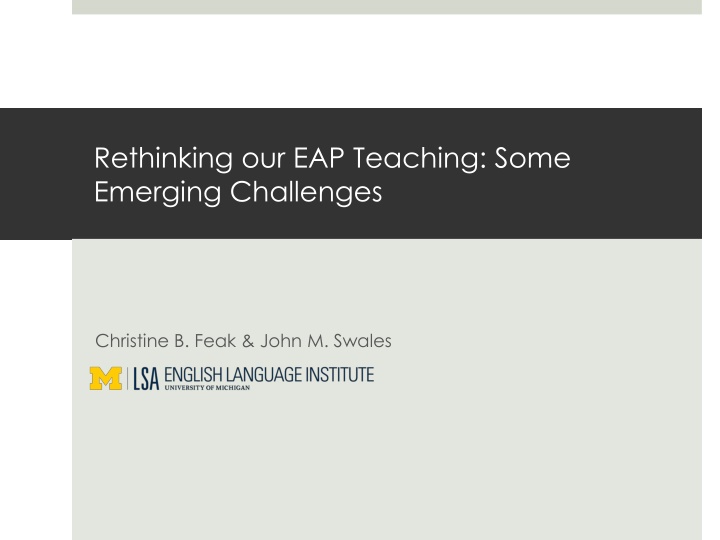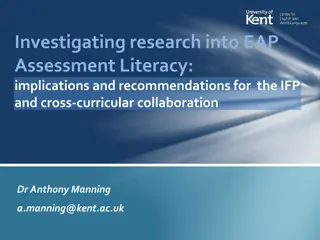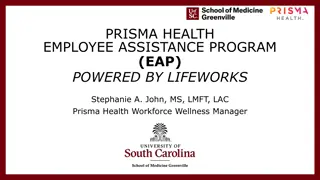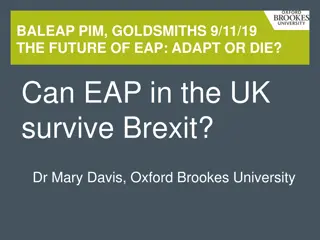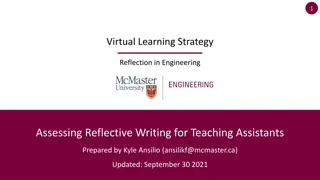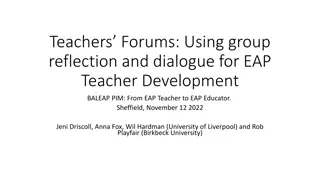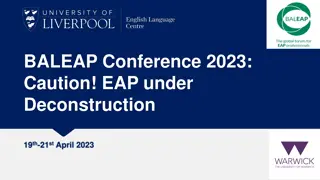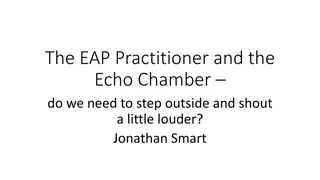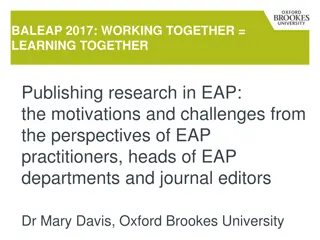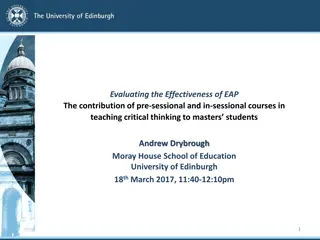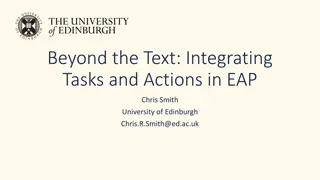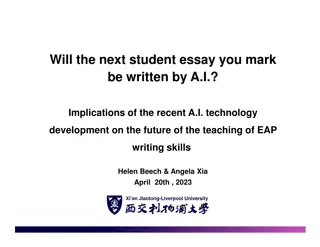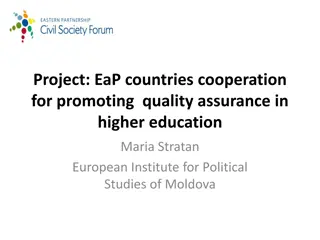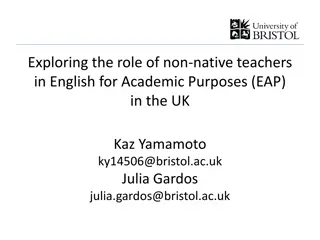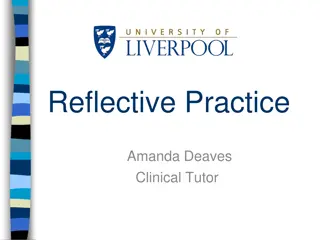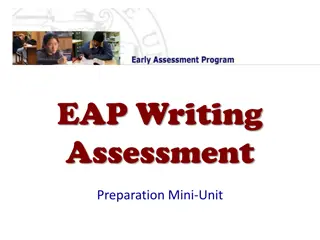Challenges and Evolution in EAP Teaching: A 30-Year Reflection
This insightful article explores the shifting landscape of English for Academic Purposes (EAP) teaching over the past three decades. It discusses emerging challenges, evolving instructional targets, and the changing dynamics of academic writing globally. The narrative delves into the vanishing center in EAP, episodes in ESP development, and the semiperiphery of academic writing, offering a comprehensive look at the field's progression and current state.
Download Presentation

Please find below an Image/Link to download the presentation.
The content on the website is provided AS IS for your information and personal use only. It may not be sold, licensed, or shared on other websites without obtaining consent from the author.If you encounter any issues during the download, it is possible that the publisher has removed the file from their server.
You are allowed to download the files provided on this website for personal or commercial use, subject to the condition that they are used lawfully. All files are the property of their respective owners.
The content on the website is provided AS IS for your information and personal use only. It may not be sold, licensed, or shared on other websites without obtaining consent from the author.
E N D
Presentation Transcript
Rethinking our EAP Teaching: Some Emerging Challenges Christine B. Feak & John M. Swales
Selected topics The vanishing center? Getting to grips with humanities texts Rethinking the targets of instruction
The vanishing center? Episodes in ESP : A source and reference book on the development of English for science and technology (1985) 15 Episodes 4 textbook extracts 4 descriptions of EST discourse 2 theoretical discussions (Widdowson; Hutchinson & Waters) 5 dealing with methodology and materials) 29 authors or co-authors (28 native speakers of English, 10 from the U.S. and the from Great Britain though often working overseas)
30 years later The Semiperiphery of Academic Writing: Discourses, Communities and Practices. (Karen Bennett, ed.) 2014 15 authors and co-authors, all non-native speakers of English, except for the editor (British) and one other contributor (from Australia) All the papers (bar one) are scholarly descriptions of the state of play in various countries (mostly E. Europe), such as The changing face of Czech academic discourse . The one exception: Teaching academic writing for the global world in Poland: The ELF perspective
30 years later So, an entirely meritorious diffusion across the world of analytic studies of academic texts, with particular strengths in: Spain Sweden Brazil (though often in Portuguese) Hong Kong Australia New Zealand And emerging strengths in mainland China, France & Iran
The old center A worrying implosion in the old center (USA, UK) Fewer doctoral opportunities in these countries Fewer professorial appointments A hard-working lecturer class Many conference presentations (as in BALEAP), but few with the will and the skill to attempt international publication
Getting to grips with humanities texts A double whammy: Only limited demand at the graduate level and the difficulty in establishing clear lines of textual development The case of the genre of describing/discussing/evaluating a creative work (a painting, poem, piece of music, film, etc.)
Three options 1. General-specific (as in empirical introductions) Let me tell you about the context (creator, historical background, social context) Now let s examine the artistic object. 1. Specific-general (as in empirical discussions) Let s have a look at the creative product, and let me walk you through its main features Now let me tell you about its creator, her ambience and the influences and effects of her work.
Three options 3. As far as I can see, at least for art objects, the preferred trajectory is a continuous switching between context and image Art-The Critics Choice Professor Paul Hills (of London University) with a large page (750 words) to talk about Botticelli s Primavera.
S1-4 Context Giovani Bellini was a master of stillness, Sandro Botticelli of movement . Florence/Alberti/Donatello . The Primavera or Spring is a fable about the power of love, told through interlinked movement of figures . Contemporary poetry; the Medici circle; new humanism S5 Image S6-10 Context S11-21 Image The narrative exceptionally reads from right to left. Discussion and interpretation of the figures S22-25 Context Discussion of Mercury in classical mythology S25-27 Image The role of Mercury in the picture S28-32 Context The sources for Botticelli s figures The young elite of Florence appreciated how, with lightness and grace, B. distanced the body from the common and base.
Other features of the genre The exegetic role of comparisons (Bellini-stillness; Botticelli- movement) Discoursal silences; almost no refs to the scholarly literature The helpful role of parenthetical information Difficulties in teasing out description v. characterization vs. evaluation (c.f. Tucker, Baxantall) The narrative exceptionally reads from right to left. (?) Epistemic modality and the biographer s assertive speculations . When he visited Venice, he must have seen Bellini s
How well are we dealing with other writing? Letters of recommendation Appeal letters Memos Tweets (tweet your dissertation)
Tweet your dissertation When thinking big, small matters. Using scientific computing to demonstrate how small-scale processes have large hydrological impacts. How blurry are the boundaries? Examining interactions between production and conservation forests in Indonesian villages. Can we drink and drive? Minimizing the impacts of bioenergy policy on water quality Prepared or not assessing the state of local adaptation planning and action in U.S.
Tweet your dissertation Good intentions=good execution? 8 in 10 firms can t tell if their products are conflict minerals-free, even if they care about the issue. Where s this new frog disease from? It s not from Africa, we know that much. Where do we go from here? We re following the clues to Brazil. Urban resilience for whom, what, when, where, and why? The challenge of planning green infrastructure for resilience in coastal megacities How does the built environment cultivate justice and injustice? Environments help to make political groups who demand just environments.
Tweet your dissertation How many people does it take to recycle a vacant building? Find out:[link to photo series] Environmentally active occupants or mindless consumers? Green buildings and the behavioral impact of an educated and engaged building occupant tweet tweet, a picture is worth 1k words but might mislead; what sound can tell us about the environment in a visual culture Unintended consequences of treating drinking water microbes with chemicals
Other writing that graduate students may need to do Manuscript reviews Responses to reviewer comments Cover letters Teaching philosophies Funding requests (external or internal)
Other writing that graduate students may need to do Biostatements How can students learn to do these well? Blogs Email (definitely) Non-specialist abstracts and summaries (for Institutional Review Boards approval, research publications and other grant proposals) Other non-specialist communications
Why do students need to develop skills to communicate with non-specialists? Not all students pursuing a Ph.D. are interested in academic careers. Professional Ph.D.s are becoming increasingly attractive to those interested in the public and private sectors. Doctor of Economic Development (DED) Doctor of Public Administration (DPA) Doctor of Business Administration (DBA) Doctor of Audiology (D. Aud.)
Why do students need to develop skills to communicate with non-specialists? Academics are increasingly being expected to be able to communicate with non-specialists. Project summaries of a National Science Foundation grant proposal Sponsored research from non-government sources Communications with policy makers (or more likely their staff) Interdisciplinary research Research articles in journals that require a non-specialist abstract
Why do students need to develop skills to communicate with non-specialists? Brecel nicked the fourth frame then took the fifth with a run of 72. Walden had chances in the next but missed the last red and later failed on a thin cut on the final blue. When Brecel potted blue, pink and black, the momentum was firmly behind him. A quickfire break of 90 put him 4-3 ahead. Frame eight came down to the last red, and a poor safety from Brecel appeared to give Walden the opportunity to force a decider. But he went in-off in potting the red, and Brecel cleared to the pink for victory.
Epigenetic Control of Expression of the Key Lineage Determining Factors PU.1 and RUNX1 in Myelopoiesis and Lineage Specification Abstract In myelodysplastic syndrome the generation of two common hematopoietic progenitors, common myeloid progenitor (CMPs) and common lymphoid progenitors (CLMs), from hematopoietic stem cells is tightly regulated by a small group of key transcription factors such as PU.1 and RUNX1. Any changes in these key transcription factors will cause aberrant myelopoiesis, leading to myelodysplastic syndromes or leukemia. Recent clinical studies on myelodysplastic syndrome and leukemia have shown that epigenetic alterations play an important role in the pathogenesis of these hematopoietic malignancies. However, the epigenetic regulatory mechanisms that control expressions of PU.1 and RUNX1, the key myeloid lineage determining factors, are largely unknown. The curse of knowledge
Considerations An example from published research Determining the Delamination Propensity of Pharmaceutical Glass Vials Using a Direct Stress Method Sloey, C., Gleason, C., & Phillips, J. (2013). Determining the Delamination Propensity of Pharmaceutical Glass Vials Using a Direct Stress Method. PDA Journal of Pharmaceutical Science and Technology, 67(1), 35-42.
EXPERT TO EXPERT 1An accelerated lamellae formation (ALF) methodology has been developed to determine the delamination propensity and susceptibility of pharmaceutical glass vials. 2The ALF process consists of a vial wash and depyrogenation mimic procedure followed by stressing glass vials with 20 mM glycine pH 10.0 solution at 50 C for 24 h and analyzing the resulting solutions by visual inspection for glass lamellae. 3ALF results demonstrate that while vial delamination propensity generally correlates with glass hydrolytic resistance, ALF is a more direct test of glass delamination propensity and is not affected by post- production vial washing that can affect results obtained using hydrolytic resistance tests. 4ALF can potentially be used by pharmaceutical companies to evaluate and screen incoming vial lots to minimize the risk of delamination during the shelf life of parenteral therapeutics, and by glass vial manufacturers to monitor and improve their vial manufacturing processes.
EXPERT TO NONEXPERT 1Glass flakes can sometimes appear in liquid pharmaceutical drugs contained in glass vials. 2These glass flakes are a result of several factors related to the glass vial production process, glass vial sterilization procedures, and the formulation of the liquid pharmaceutical drug. 3Vial testing is routinely done in order to select glass vials that are less likely to form glass flakes. 4The factors leading to the formation of glass flakes were studied and applied to a method designed to directly screen vials for their propensity to form glass flakes. 5The washing of vials followed immediately by sterilization at high temperatures was determined to be a critical factor in the formation of glass flakes. 6As a result, a laboratory mimic of this procedure was incorporated into the newly developed method for screening vials. 7This mimic procedure as well as robust accelerated incubation conditions and a sensitive visual inspection procedure are key aspects of this vial screening method.
The challenge of vocabulary: verbs Somerville, R. C., & Hassol, S. J. (2011). The science of climate change. Phys. Today, 64(10), 48. Scientific term enhance Nonexpert understanding? improve Alternatives intensify, increase aerosol spray can tiny particle in the atmosphere positive trend good trend upward trend theory hunch, speculation scientific understanding uncertainty being unsure, a lack of knowing range error a mistake, something wrong or incorrect preference, unfairness, preconceived negative idea difference from an exact number bias a tendency scheme a devious plan systematic plan anomaly abnormal occurrence change from long-term average
Challenges Catton, K. B., Webster, D. R., & Yen, J. (2012). The effect of fluid viscosity, habitat temperature, and body size on the flow disturbance of Euchaeta. Limnology & Oceanography: Fluids & Environments, 2, 80-92.
Abstract 1The spatial extent and temporal decay of copepod-generated hydrodynamic disturbances during cruise and escape behavior were examined using the particle image velocimetry technique combined with theoretical models. 2Our study compared results for two species in the genus Euchaeta: the larger E. elongata living in colder water of higher viscosity versus the smaller E. rimana living in warmer water of lower viscosity. 3We expected that body size and viscosity would work in opposite directions in shaping the spatial and temporal properties of the hydrodynamic disturbances generated by these two copepod species. 4We found that the spatial extent of the copepod-induced hydrodynamic signal in front of the copepods during cruising was equivalent, with the peak strength of the signal to preferred prey showing no significant difference. Lay Abstract 1Copepods are small marine invertebrates that are one of the most abundant multicellular organisms on Earth. 2They serve as an important link in the marine food chain between small oceanic plant life, called phytoplankton, and larger organisms such as fish. 3As with all organisms, they must adapt to the surrounding fluid environment. 4Since copepods are small, they inhabit an aquatic flow regime that provides a balance of inertial and fluid viscous forces on the organism. 5The flow created by copepods controls, to a large degree, the interaction with prey, predators, and other individuals of the same species. 6Hence, examination of the flow disturbances created during cruise and escape behaviors provides insight into the method and consequences of propulsion in this unique flow environment.
Mark the sentences that would likely be clear to a nonexpert with a check ( ) if you are not sure place a question mark in the blank (?). ____ 1Copepods are small marine invertebrates that are one of the most abundant multicellular organisms on Earth. ____ 2They serve as an important link in the marine food chain between small oceanic plant life, called phytoplankton, and larger organisms such as fish. ____ 3As with all organisms, they must adapt to the surrounding fluid environment. ____ 4Since copepods are small, they inhabit an aquatic flow regime that provides a balance of inertial and fluid viscous forces on the organism.
____ 5The flow created by copepods controls, to a large degree, the interaction with prey, predators, and other individuals of the same species. ____ 6Hence, examination of the flow disturbances created during cruise and escape behaviors provides insight into the method and consequences of propulsion in this unique flow environment.
The Real Challenge? There is no quick fix to writing. Mad libs
3. A noun that is an obscure research area This paper presents a 1. _______ method for 4. A method someone else invented 2. _______ (the) 3. _______ . Using 4. ______ , 5. A noun property of something the 5. _______ was measured to be 6. ______ 6. A number + units of some kind . Results show 7. _______ agreement with 7. An adjective that indicates something really good theoretical predictions and significant 8. Some poor author improvement over previous efforts by 8. 9. An adjective that indicates importance _______ , et al. The work presented here has 9. _______ implications for future studies of 10. A noun that is a buzzword 10. _______ and will contribute to 11. A big, fancy noun that captures something of great social concern addressing the problem of 11. _______ . 1. An adjective that means new (based on Ph.D. comics http://www.phdcomics.com/comics/archive.php?com icid=1121 2. A fancy research verb
Challenges Are the perspectives on EAP communication support on target? academic purpose means academia a fix-it service for L2 students who are at risk L2 student support during the first couple of semesters exclusively for L2 speakers of English L1 student support in the final few semesters (dissertation stage) Are these perspectives out of touch with the needs of today s students?
Challenges For L2 students do we focus on proficiency? Pre-matriculation? Post-matriculation? Whether enrolled L2 students are ready or not to handle their coursework in terms of proficiency, they must do the same tasks as all other students
Challenges What about the students current communication demands? What s wrong with emphasizing proficiency? evidence that proficiency is a good predictor of academic risk is not particularly compelling proficient students and other expert users of English are locked out of EAP support and believed to have the linguistic and social capital needed for success
Challenges Understanding genres Differences across disciplines and sub-disciplines A thesis (dissertation) proposal 25-page literature review that concludes with research questions and an approach to investigating them? the first three chapters of a traditional thesis (dissertation )?
Addressing the Challenges There is still a place for EAP classes for less proficient students, but EAP programs need to offer a range of courses that attract and reach out to students of all levels of English proficiency and who are at various stages of their degree programs.
Addressing the Challenges We may have conceptions and preconceptions that we bring to our EAP teaching Some preconceptions may be misconceptions We need to reconsider which students may need support and when that support is needed. We need a better understanding of our students and more knowledge of the writing and speaking demands that our they face.
Addressing the Challenges And . . . . ?
Thank you! cfeak@umich.edu jmswales@umich.edu
